#mohammed vi
Explore tagged Tumblr posts
Text
4 notes
·
View notes
Text
HM the King Delivers Speech to Parliament at Opening of First Session of 4th Legislative Year of 11th Legislature
HM King Mohammed VI, accompanied by HRH Crown Prince Moulay El Hassan and HRH Prince Moulay Rachid, on Friday delivered a speech to the Parliament at the opening of the first session of the fourth legislative year of the 11th Legislature. Here follows the full text of the Royal speech: “Praise be to God May peace and blessings be upon the Prophet, His Kith and Kin Honourable Members of…
0 notes
Photo

New Post has been published on https://maroctvinfo.com/le-maroc-en-ebullition-mohammed-vi-sous-lemprise-des-freres-zaiter-une-menace-pour-la-stabilite-du-pays/
Le Maroc en ébullition : Mohammed VI sous l'emprise des frères Zaïter, une menace pour la stabilité du pays

Au Maroc, une crise politique et sociale d’envergure se profile, mettant en lumière une relation troublante entre le roi Mohammed VI et les frères Zaïter. Selon le journal tchèque « idnes.cz », Mohammed VI aurait été privatisé par ces lutteurs germano-marocains, ce qui suscite une inquiétude grandissante au sein du pays. Dans cet article approfondi, nous examinerons en détail les tenants et aboutissants de cette relation, les implications pour le Maroc et les conséquences potentielles de cette crise qui menace la stabilité du pays.
L’influence grandissante des frères Zaïter sur Mohammed VI
Les frères Zaïter, en particulier Abu Bakr, ont réussi à tisser des liens étroits avec le roi Mohammed VI, au point de l’influencer considérablement. Bien que les frères Zaïter aient un passé judiciaire troublant, cela ne semble pas avoir entravé leur ascension dans les cercles du pouvoir marocain. Leur relation étroite avec Mohammed VI soulève des doutes quant à la capacité du roi à gouverner de manière indépendante et à prendre des décisions éclairées pour le bien du pays. La privatisation présumée du roi par les frères Zaïter soulève des inquiétudes quant à la gouvernance effective du Maroc et à la préservation des intérêts du peuple marocain.
Les frères Zaïter ont su gagner la confiance et l’influence de Mohammed VI grâce à leurs réalisations dans le monde de la boxe. Cependant, leur ascension rapide soulève des questions sur les motivations derrière cette relation étroite. Leur implication dans les affaires politiques et la prise de décisions importantes au nom du roi ont semé le doute quant à la transparence et à l’intégrité de la gouvernance marocaine.
Les conséquences politiques et sociales de la privatisation du roi
La privatisation alléguée de Mohammed VI par les frères Zaïter a semé la panique au Maroc, remettant en question la stabilité du pays. Le roi, qui est considéré comme l’un des monarques les plus riches du monde, aurait délégué une grande partie de ses responsabilités et de son pouvoir aux frères Zaïter. Cette situation soulève des inquiétudes quant à la gouvernance équilibrée et à la prise de décisions éclairées.
En outre, l’utilisation abusive des ressources publiques par les frères Zaïter a suscité la colère et le mécontentement parmi la population marocaine. Les rapports faisant état de l’utilisation de voitures de luxe et d’avions d’État à des fins personnelles soulèvent des questions sur l’intégrité et la responsabilité des dirigeants marocains. Cette situation alimente les inégalités sociales et renforce le sentiment de frustration parmi les citoyens ordinaires qui luttent pour subvenir à leurs besoins fondamentaux.
Les défis pour l’avenir du Maroc
La crise actuelle au Maroc, avec Mohammed VI apparemment sous l’emprise des frères Zaïter, soulève des questions cruciales sur l’avenir du pays. La gouvernance affaiblie du roi menace la stabilité politique et sociale, et compromet la confiance du peuple marocain envers ses dirigeants. Pour assurer un avenir durable et prospère, des mesures urgentes doivent être prises pour rétablir la confiance, renforcer les institutions démocratiques et restaurer l’autorité du roi Mohammed VI.
Le Maroc a besoin d’une gouvernance transparente et responsable, où les intérêts du peuple sont placés au premier plan. Une réforme politique et économique est nécessaire pour promouvoir la participation citoyenne, réduire les inégalités et garantir l’égalité des chances pour tous les Marocains. Il est essentiel de mettre en place des mécanismes de responsabilisation et de lutte contre la corruption afin de restaurer la confiance du peuple marocain dans ses dirigeants.
La crise actuelle au Maroc, avec Mohammed VI apparemment sous l’emprise des frères Zaïter, représente une menace significative pour la stabilité du pays. La gouvernance affaiblie et l’utilisation abusive des ressources publiques remettent en question l’intégrité et la responsabilité des dirigeants marocains. Pour préserver l’unité et la prospérité du Maroc, des mesures urgentes doivent être prises pour rétablir la confiance, renforcer les institutions démocratiques et restaurer l’autorité du roi Mohammed VI. L’avenir du Maroc dépend de la volonté des dirigeants de répondre aux aspirations du peuple marocain et de promouvoir une gouvernance transparente et responsable.
0 notes
Text


By Sam Metz
September 11, 2023
An earthquake has sown destruction and devastation in Morocco, where death and injury counts continue to rise as rescue crews dig out people both alive and dead in villages that were reduced to rubble.
Law enforcement and aid workers — both Moroccan and international — have arrived in the region south of the city of Marrakech that was hardest hit by the magnitude-6.8 tremor on Friday night and several aftershocks.
Residents await food, water and electricity, and giant boulders now block steep mountain roads.
Here’s what you need to know:
WHAT ARE THE AREAS MOST AFFECTED?
The epicenter was high in the Atlas Mountains about 70 kilometers (44 miles) south of Marrakech in Al Haouz province.
The region is largely rural, made up of red-rock mountains, picturesque gorges and glistening streams and lakes.
For residents like Hamid Idsalah, a 72-year-old mountain guide from the Ouargane Valley, it is unclear what the future holds.
Idsalah relies on Moroccan and foreign tourists who visit the region due to its proximity to both Marrakech and Toubkal, North Africa’s tallest peak and a destination for hikers and climbers.
“I can’t reconstruct my home. I don’t know what I’ll do. Still, I’m alive so I’ll wait,” he said as rescue teams traversed the unpaved road through the valley for the first time this weekend.
The earthquake shook most of Morocco and caused injury and death in other provinces, including Marrakech, Taroudant and Chichaoua.
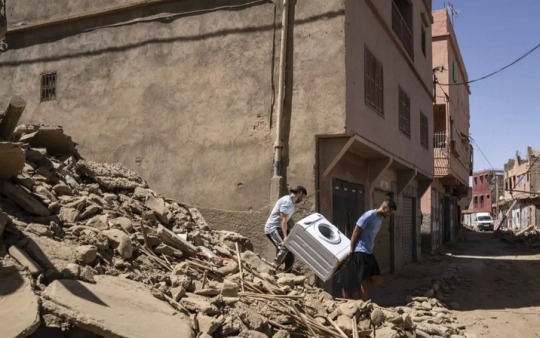
WHO WAS AFFECTED?
Of the 2,122 deaths reported as of Sunday evening, 1,351 were in Al Haouz, a region with a population of around 570,000, according to Morocco’s 2014 census.
People speak a combination of Arabic and Tachelhit, Morroco’s most common Indigenous language.
Villages of clay and mud brick built into mountainsides have been destroyed.
Though tourism contributes to the economy, the province is largely agrarian.
And like much of North Africa, before the earthquake, Al Haouz was reckoning with record drought that dried rivers and lakes, imperiling the largely agricultural economy and way of life.
Outside a destroyed mosque in the town of Amizmiz, Abdelkadir Smana said the disaster would compound existing struggles in the area, which had reckoned with the coronavirus pandemic in addition to the drought.
“Before and now, it’s the same,” said the 85-year-old. “There wasn’t work or much at all.”
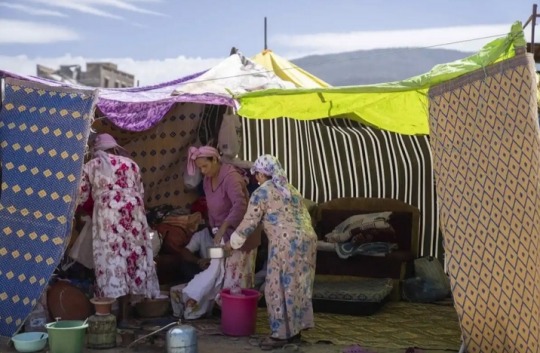
WHO IS PROVIDING AID?
Morocco has deployed ambulances, rescue crews and soldiers to the region to help assist with emergency response efforts.
Aid groups said the government has not made a broad appeal for help and accepted only limited foreign assistance.
The Interior Ministry said it was accepting search and rescue-focused international aid from Spain, Qatar, Britain and the United Arab Emirates, bypassing offers from French President Emmanuel Macron and U.S. President Joe Biden.
“We stand ready to provide any necessary assistance for the Moroccan people,” Biden said Sunday on a trip to Vietnam.
WHY IS MARRAKECH HISTORIC?
The earthquake cracked and crumbled parts of the walls that surround Marrakech’s old city, a UNESCO World Heritage site built in the 12th century.
Videos showed dust emanating from parts of the Koutoubia Mosque, one of the city’s best known historic sites.
The city is Morocco’s most widely visited destination, known for its palaces, spice markets, tanneries and Jemaa El Fna, its noisy square full of food vendors and musicians.

HOW DOES THIS COMPARE TO OTHER QUAKES?
Friday’s earthquake was Morocco’s strongest in over a century but, though such powerful tremors are rare, it isn’t the country’s deadliest.
Just over 60 years ago, the country was rocked by a magnitude-5.8 quake that killed over 12,000 people on its western coast, where the city of Agadir, southwest of Marrakech, crumbled.
That quake prompted changes in construction rules in Morocco, but many buildings, especially rural homes, are not built to withstand such tremors.
There had not been any earthquakes stronger than magnitude 6.0 within 310 miles (500 kilometers) of Friday’s tremor in at least a century, according to the U.S. Geological Survey.
Northern Morocco experiences earthquakes more often, including tremors of magnitude 6.4 in 2004 and magnitude 6.3 in 2016.
Elsewhere this year, a magnitude 7.8 temblor that shook Syria and Turkey killed more than 21,600 people.
The most devastating earthquakes in recent history have been above magnitude 7.0, including a 2015 tremor in Nepal that killed over 8,800 people and a 2008 quake that killed 87,500 in China.
WHAT ARE THE NEXT STEPS?
Emergency response efforts are likely to continue as teams traverse mountain roads to reach villages hit hardest by the earthquake.
Many communities lack food, water, electricity, and shelter.
But once aid crews and soldiers leave, the challenges facing hundreds of thousands who call the area home will likely remain.
Members of the Moroccan Parliament are scheduled to convene Monday to create a government fund for earthquake response at the request of King Mohammed VI.
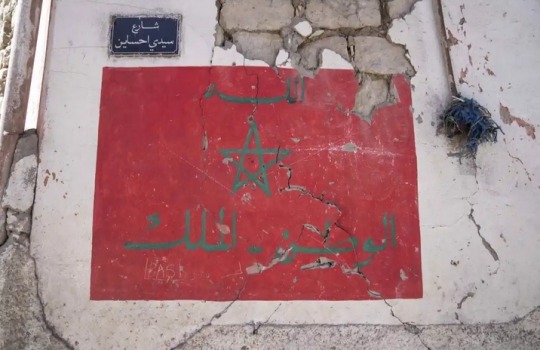
#Morocco#Morocco Earthquake#earthquake#Marrakech#Al Haouz province#Atlas Mountains#Taroudant#Chichaoua#Interior Ministry#Koutoubia Mosque#Moroccan Parliament#King Mohammed VI
93 notes
·
View notes
Text

Avenue Mohammed VI, Tangier, Morocco
Linda Gerbec
4 notes
·
View notes
Text
L hôpital du roi à Marrakech !!!!!
L hôpital Mohamed VI refuse de soigner les blessés et les malades qui n'ont pas d argent !!!
5 notes
·
View notes
Text
moroccan media will often put "SM" before "mohammed VI" which is "his majesty" but in french+abbreviated but i still read it like sadomasochism mohammed VI sometimes
#na na na come on ......#the moroccan french agency twitter account is so funny theyre just posting shit .... djokovic just got congratulated for yesterday's win#sm entertainment mohammed VI#******* moroccan press agency
7 notes
·
View notes
Text
Tumblr idiots who were loudly denouncing the Queen of England for imaginary crimes last year sure are silent this time around about the Kingdom of Morocco and its awful king. Priorities of the PC police always on point.
Constitutional European monarchies = evil
Authoritarian monarchies everywhere else = beautiful, how dare you criticize them evil colonialist
#Mohammed VI who would rather his citizens die and not be rescued than allow help from countries he is upset at#for absolutely petty reasons#because he wants Western Sahara to be his#if there is one thing that is in abundance worldwide it's hypocrisy
1 note
·
View note
Text
No way, No fuckin' way
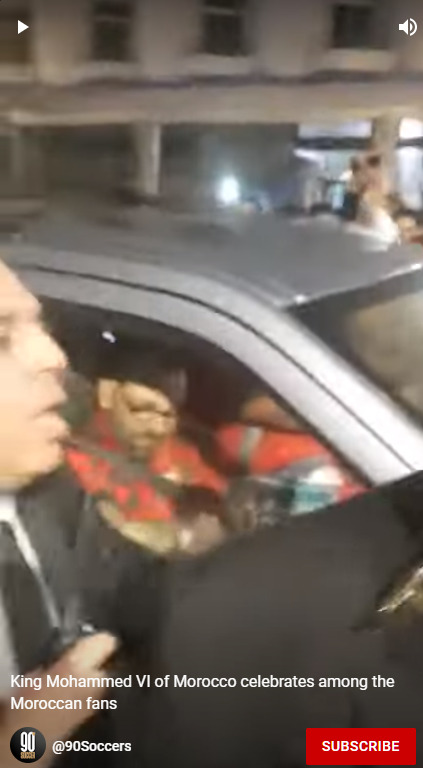
5 notes
·
View notes
Text

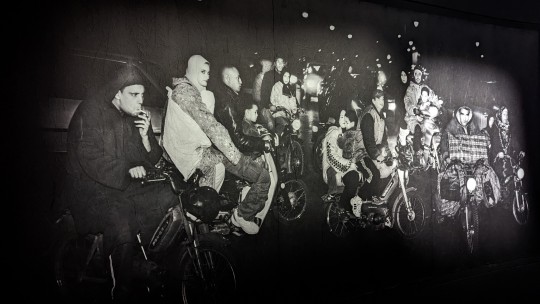

#tagyourself moment at the art gallery.
#art gallery#mohammed vi museum of contemporary art#rabat#morocco#travel#tag yourself#notes from the road#my posts#buggy to morocco
1 note
·
View note
Note
Hello
People of compassionate hearts, if you are living in peace, congratulations to you, but my family is living under bombing, destruction and genocide in Gaza.
My family is in danger of worrying about my family I can't sleep because
Please help me before it's too late so I can get them out of Gaza
This is the case in Gaza, destruction everywhere please do not leave them alone, and thanks to everyone who contributes or donates Or contribute to publishing, thank you
.
0 notes
Text
ICMEI Congratulates the Kingdom of Morocco on the 25th Anniversary of the Enthronement of His Majesty King Mohammed VI

New Delhi, August 10, 2024 – The International Chamber of Media and Entertainment Industry (ICMEI) extended its heartfelt congratulations to His Excellency Mohamed Maliki, the Ambassador of the Kingdom of Morocco, and the people of Morocco on the momentous occasion of the 25th Anniversary of the Enthronement of His Majesty Mohammed VI, King of Morocco. The grand celebration took place at Hotel Leela, New Delhi, where dignitaries and diplomats gathered to commemorate this significant milestone in Morocco’s history.
In a statement, Dr. Sandeep Marwah, President of ICMEI, expressed his admiration for the leadership of His Majesty King Mohammed VI and the progress Morocco has made under his reign. “This celebration is a testament to the enduring legacy of His Majesty King Mohammed VI, whose visionary leadership has brought about remarkable growth and development in Morocco. We are honored to join in the celebration of this historic occasion and to reaffirm the strong ties between India and Morocco,” said Dr. Marwah.
To further strengthen the cultural and bilateral relations between India and Morocco, ICMEI, in association with the Embassy of Morocco, established the Indo Morocco Film and Cultural Forum. The Forum was created with the mission to enhance and promote cultural exchanges, collaboration in the fields of cinema, art, and media, and to foster deeper connections between the people of both nations.
The Indo Morocco Film and Cultural Forum has been instrumental in organizing various cultural events, film festivals, and exchange programs that showcase the rich heritage and traditions of both India and Morocco. These initiatives have played a crucial role in building bridges of friendship and understanding between the two countries.
The 25th Anniversary of the Enthronement of His Majesty King Mohammed VI serves as a reminder of the enduring relationship between India and Morocco, built on mutual respect, shared values, and a commitment to cultural diplomacy. ICMEI remains dedicated to supporting and advancing these relations through continued collaboration and initiatives that celebrate the diverse cultures of both nations.
#ICMEI Congratulates the Kingdom of Morocco on the 25th Anniversary of the Enthronement of His Majesty King Mohammed VI#Dr. Sandeep Marwah President of ICMEI
0 notes
Photo

New Post has been published on https://maroctvinfo.com/mohammed-vi-face-a-la-sarcoidose-une-epreuve-de-sante-qui-souleve-des-questions-sur-sa-capacite-a-gouverner/
Mohammed VI face à la sarcoïdose : une épreuve de santé qui soulève des questions sur sa capacité à gouverner

Mohammed VI, le roi du Maroc, est apparu récemment très amaigri lors d’une apparition publique, soulevant des questions sur sa capacité à continuer à gouverner efficacement le pays face à une maladie potentiellement invalidante, la sarcoïdose.
La sarcoïdose, une maladie auto-immune qui affecte principalement les poumons et les ganglions lymphatiques, évolue rapidement et peut entraîner des symptômes comme des difficultés respiratoires, une perte de poids et une fatigue importante. Ces symptômes, qui semblent avoir déjà affecté l’apparence physique du roi Mohammed VI, pourraient entraver sa capacité à gouverner le Maroc avec la même vigueur qu’auparavant.
Le monarque a réduit ses apparitions publiques, sans doute en raison de son état de santé. Sa présence récente lors de la présentation d’un véhicule entièrement marocain à Rabat témoigne de sa volonté de rester engagé, mais ne peut dissiper totalement les inquiétudes sur son aptitude à gouverner à long terme.
La sarcoïdose n’est pas une maladie à prendre à la légère. Certes, environ la moitié des cas de sarcoïdose se résolvent spontanément en l’espace de trois ans, selon les Hospices civils de Lyon, mais cela signifie également que la moitié des patients continuent à lutter contre cette maladie bien après ce délai.
En ce sens, la condition de Mohammed VI soulève des interrogations légitimes. Si la maladie persiste, la capacité du roi à remplir ses fonctions avec la même intensité et la même détermination pourrait être sérieusement compromise.
Les Marocains attendent donc de voir comment leur roi naviguera à travers cette épreuve de santé. Sa résilience face à la maladie a jusqu’à présent été admirée, mais les citoyens et les observateurs se demandent si cela sera suffisant pour assurer un leadership stable et efficace dans les années à venir.
0 notes
Text
30 juillet : la fête du trône au Maroc
Ce 24e anniversaire de l'intronisation du roi Mohammed VI se déroule dans une période de flottement pour l’avenir un monarque qui est loin d'avoir tenu toutes ses promesses et qui semble fatigué de régner. À tel point qu’on s’attend à tout moment à ce qu’il cède le trône à son fils, Moulay El Hassan, qui vient de fêter ses 20 ans. Mohammed VI Ben al-Hassan avait été déclaré officiellement roi le 30 juillet 1999.
Ce jour férié, chaque 30 juillet pour la Fête du trône (عيد العرش), est l’une des rares fêtes civiles de l'année, elle est l'occasion pour le roi de s'adresser à son peuple. En 2022, il avait prôné une réforme du code de la famille pour instaurer plus d’égalité entre les femmes et les hommes. Cette année, Mohammed VI a adressé son discours à la nation, retransmis sur les ondes de la radio et à la télévision à 21h, ce samedi 29 juillet. Il a appelé de ses vœux une normalisation des relations avec l’Algérie.
Ce dimanche après-midi, le roi préside une réception dans la ville de M’diq. Chef suprême et chef d’Etat-major général des Forces armées royales, Mohammed VI présidera, lundi après-midi au Palais royal de Tétouan, la cérémonie de prestation de serment par les officiers, nouveaux lauréats des différents écoles et instituts militaires, paramilitaires et civils. C’est, en effet, l’occasion pour le roi de recevoir les hauts dignitaires du royaume, de présider différentes manifestation, enfin d'accorder sa grâce à des condamnés.
Un article de l'Almanach international des éditions BiblioMonde
Dans notre catalogue : Géopolitique du Maroc par Kader Abderrahim
0 notes
Text
Little is known of the prehistory of Western Sahara, although Neolithic (New Stone Age) rock engravings in Saguia el-Hamra and in isolated locations in the south suggest that it was occupied by a succession of hunting and pastoral groups, with some agriculturists in favoured locales, prior to a gradual process of desertification that began about 2500 bce. By the 4th century bce there was trade between Western Sahara and Europe across the Mediterranean; the Phoenicians sailed along the west coast of Africa in this period. The Romans also had some contact with the Saharan peoples. By medieval times this part of the Sahara was occupied by Ṣanhajāh Amazigh (Berber) peoples who were later dominated by Arabic-speaking Muslim Bedouins from about 1000 ce.
In 1346 the Portuguese discovered a bay that they mistakenly identified with a more southerly Río de Oro, probably the Sénégal River. The coastal region was little explored by Europeans until Scottish and Spanish merchants arrived in the mid-19th century, although in 1476 a short-lived trading post, Santa Cruz de Mar Pequeña, was established by Diego García de Herrera, a Spaniard. In 1884 Emilio Bonelli, of the Sociedad Española de Africanistas y Colonistas (“Spanish Society of Africanists and Colonists”), went to Río de Oro bay and signed treaties with the coastal peoples. Subsequently, the Spanish government claimed a protectorate over the coastal zone. Further Spanish penetration was hindered by French claims to Mauritania and by partisans of Sheikh Māʾ al-ʿAynayn, who between 1898 and 1902 constructed the town of Semara at an inland oasis. Cape Juby (Ṭarfāyah) was occupied for Spain by Col. Francisco Bens in 1916, Güera was occupied in 1920, and Semara and the rest of the interior were occupied in 1934.
In 1957 the territory was claimed by Morocco, which itself had just reached independence the previous year. Spanish troops succeeded in repelling Moroccan military incursions into the territory, and in 1958 Spain formally united Río de Oro and Saguia el-Hamra into a Spanish province known as Spanish Sahara. However, the situation was further complicated by newly independent Mauritania’s claims to the province in 1960, and in 1963 huge phosphate deposits were discovered at Bu Craa in the northern portion of the Spanish Sahara, which made the province a potentially economically valuable prize for any country that could firmly establish possession of it. Mining of the deposits at Bu Craa began in 1972.
Decades of social and economic change caused by drought, desertification, and the impact of the phosphate discoveries resulted in an increase in national consciousness and anticolonial sentiment. A guerrilla insurgency by the Spanish Sahara’s indigenous inhabitants, the nomadic Sahrawis, sprang up in the early 1970s, calling itself the Popular Front for the Liberation of Saguia el-Hamra and Río de Oro (Polisario Front). The insurgency led Spain to declare in 1975 that it would withdraw from the area. Faced with consistent pressure from Morocco and Mauritania and itself undergoing a period of domestic uncertainty, Spain agreed to the partition of Western Sahara between the two countries despite a World Court ruling that Morocco’s and Mauritania’s legal claims to the Spanish Sahara were tenuous and did not negate the right to self-determination by the Sahrawis. Morocco gained the northern two-thirds of the area and, consequently, control over the phosphates; Mauritania gained the southern third. Sporadic fighting developed between the Polisario Front, which was supported by and based in Algeria, and the Moroccan forces. In 1976 the Polisario Front declared a government-in-exile of what it called the Saharan Arab Democratic Republic (a government recognized by some 70 countries), and it continued to raid Mauritanian and Moroccan outposts in Western Sahara.
Mauritania bowed out of the fighting and reached a peace agreement with the Polisario Front in 1979, but in response Morocco promptly annexed Mauritania’s portion of Western Sahara. Morocco fortified the vital triangle formed by the Bu Craa mines, Laayoune, and Semara while the Polisario Front guerrillas continued their raids. A United Nations (UN) peace proposal in 1988 specified a referendum for the indigenous Sahrawis to decide whether they wanted an independent Western Sahara under Polisario Front leadership or whether the territory would officially become part of Morocco. This peace proposal was accepted by both Morocco and the Polisario Front, and the two sides agreed to a cease-fire in 1991. As a UN administrative and peacekeeping force arrived in Western Sahara to prepare to conduct the referendum, however, Morocco moved tens of thousands of “settlers” into the territory and insisted that they have their voting qualifications assessed. This drawn-out procedure, which involved questions regarding the definition of who among the traditionally nomadic Sahrawis would be entitled to cast a ballot, continued throughout the 1990s and into the early 21st century. Meanwhile, Morocco continued to expand its physical infrastructure in Western Sahara despite widespread protests against its presence in the areas under its control.
During this time the Polisario Front continued its campaign despite a number of setbacks. Among the challenges were defections from the organization and a reduction in support by its primary backer, Algeria, as that country was forced to concentrate on its own internal problems. Algeria’s diplomatic campaign on behalf of Sahrawi self-determination, however, continued unabated. By 2001 tens of thousands of Sahrawis, including numerous Polisario Front soldiers, had relocated to semipermanent refugee camps in Algeria.
The turn of the century brought with it a change in approach toward peace and self-determination. After the death of Moroccan King Hassan II, Muḥammad VI took the throne and announced in 2001 that Morocco would no longer agree to hold a referendum in Western Sahara. The UN likewise began to explore alternative solutions to the 1988 proposal. In 2003 it proposed autonomy for the territory for five years, followed by a referendum, but Morocco rejected the proposal. In 2007 Morocco proposed autonomy but made no offer for a referendum. After the United States insisted in 2018 that the continued presence of UN peacekeeping forces be contingent on progress made toward settling the long-running dispute, Morocco and the Polisario Front met in December of that year to renew discussion over the situation. The continued negotiations bore little fruit, however, and the UN renewed its peacekeeping mission nonetheless.
In the latter half of 2020, the Polisario Front, seeking to force change in the status quo, began obstructing a key trade route between Morocco and Mauritania. Morocco launched a military operation in November to break the blockade, prompting the Polisario Front to announce that it would no longer observe the 1991 cease-fire agreement. In December the United States became the first country to formally recognize Moroccan sovereignty over Western Sahara, in exchange for Morocco’s normalization of ties with Israel; Israel became the second country to make the recognition in 2023, in exchange for Morocco’s agreement to open an embassy in Tel Aviv.
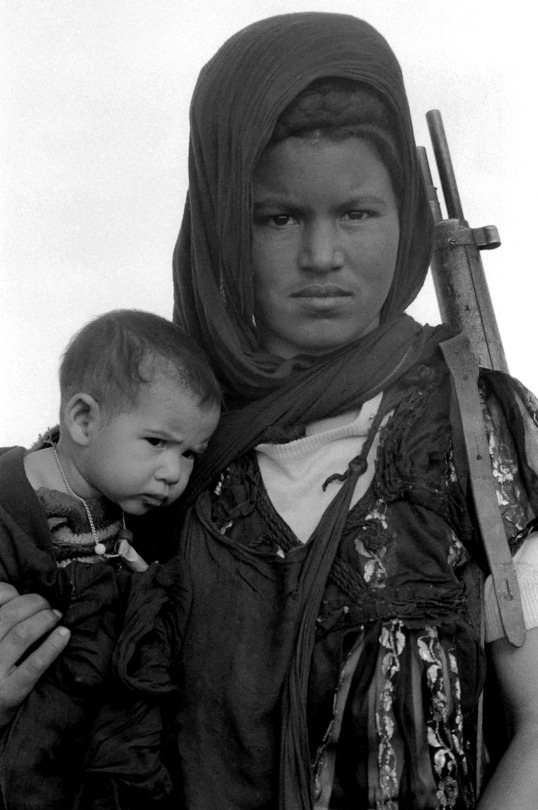
A woman holds her child and a rifle during training of Polisario soldiers in Western Sahara, 1976 - by Christine Spengler (1945), French
#studyblr#history#military history#colonialism#industry#neolithic#western sahara#sahrawi arab democratic republic#spanish sahara#spanish empire#spain#amazigh#sanhaja#morocco#mauritania#algeria#río de oro#saguia el-hamra#santa cruz de la mar pequeña#smara#cape juby#la güera#bou craa#laayoune#diego garcía de herrera#emilio bonelli#ma al-'aynayn#francisco bens#mohammed vi of morocco#phosphate
176 notes
·
View notes